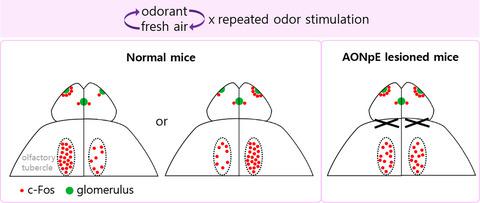当前位置:
X-MOL 学术
›
FEBS Open Bio
›
论文详情
Our official English website, www.x-mol.net, welcomes your feedback! (Note: you will need to create a separate account there.)
Interhemispheric asymmetry of c-Fos expression in glomeruli and the olfactory tubercle following repeated odor stimulation.
FEBS Open Bio ( IF 2.6 ) Pub Date : 2020-04-13 , DOI: 10.1002/2211-5463.12851 YoonGyu Jae 1 , NaHye Lee 1 , Dae Won Moon 2 , JaeHyung Koo 2, 3
FEBS Open Bio ( IF 2.6 ) Pub Date : 2020-04-13 , DOI: 10.1002/2211-5463.12851 YoonGyu Jae 1 , NaHye Lee 1 , Dae Won Moon 2 , JaeHyung Koo 2, 3
Affiliation

|
Odor adaptation allows the olfactory system to regulate sensitivity to different stimulus intensities, which is essential for preventing saturation of the cell‐transducing machinery and maintaining high sensitivity to persistent and repetitive odor stimuli. Although many studies have investigated the structure and mechanisms of the mammalian olfactory system that responds to chemical sensation, few studies have considered differences in neuronal activation that depend on the manner in which the olfactory system is exposed to odorants, or examined activity patterns of olfactory‐related regions in the brain under different odor exposure conditions. To address these questions, we designed three different odor exposure conditions that mimicked diverse odor environments and analyzed c‐Fos‐expressing cells (c‐Fos+ cells) in the odor columns of the olfactory bulb (OB). We then measured differences in the proportions of c‐Fos‐expressing cell types depending on the odor exposure condition. Surprisingly, under the specific odor condition in which the olfactory system was repeatedly exposed to the odorant for 1 min at 5‐min intervals, one of the lateral odor columns and the ipsilateral hemisphere of the olfactory tubercle had more c‐Fos+ cells than the other three odor columns and the contralateral hemisphere of the olfactory tubercle. However, this interhemispheric asymmetry of c‐Fos expression was not observed in the anterior piriform cortex. To confirm whether the anterior olfactory nucleus pars externa (AONpE), which connects the left and right OB, contributes to this asymmetry, AONpE‐lesioned mice were analyzed under the specific odor exposure condition. Asymmetric c‐Fos expression was not observed in the OB or the olfactory tubercle. These data indicate that the c‐Fos expression patterns of the olfactory‐related regions in the brain are influenced by the odor exposure condition and that asymmetric c‐Fos expression in these regions was observed under a specific odor exposure condition due to synaptic linkage via the AONpE.
中文翻译:

反复刺激后,肾小球和嗅结节中c-Fos表达的半球不对称性。
气味适应可使嗅觉系统调节对不同刺激强度的敏感性,这对于防止细胞转导机制饱和并保持对持久性和重复性气味刺激的高敏感性至关重要。尽管许多研究调查了对化学感觉作出反应的哺乳动物嗅觉系统的结构和机制,但很少有研究考虑神经元激活的差异,这些差异取决于嗅觉系统暴露于增味剂的方式,或者研究了嗅觉活动模式。不同气味暴露条件下大脑中的相关区域。为了解决这些问题,我们设计了三种不同的气味暴露条件,以模拟不同的气味环境,并分析了嗅球(OB)气味列中的c-Fos表达细胞(c-Fos +细胞)。然后,我们根据异味暴露条件测量了c-Fos表达细胞类型比例的差异。令人惊讶的是,在特定的气味条件下,嗅觉系统以5分钟的间隔反复暴露于气味剂中1分钟,侧面气味柱和嗅结节的同侧半球中的一个具有比其他气味柱更多的c-Fos +细胞三个气味柱和嗅结节的对侧半球。但是,在梨状前皮层中未观察到这种c-Fos表达的半球不对称性。为了确认前嗅核是否在外部(AONpE),连接左和右OB的这种不对称现象,在特定的气味暴露条件下分析了AONpE损伤的小鼠。在OB或嗅结节中未观察到不对称的c-Fos表达。这些数据表明,大脑中嗅觉相关区域的c-Fos表达模式受气味暴露条件的影响,并且在特定的气味暴露条件下,由于通过突触进行的突触连接,在这些区域中观察到了不对称的c-Fos表达。 AONpE。
更新日期:2020-04-13
中文翻译:

反复刺激后,肾小球和嗅结节中c-Fos表达的半球不对称性。
气味适应可使嗅觉系统调节对不同刺激强度的敏感性,这对于防止细胞转导机制饱和并保持对持久性和重复性气味刺激的高敏感性至关重要。尽管许多研究调查了对化学感觉作出反应的哺乳动物嗅觉系统的结构和机制,但很少有研究考虑神经元激活的差异,这些差异取决于嗅觉系统暴露于增味剂的方式,或者研究了嗅觉活动模式。不同气味暴露条件下大脑中的相关区域。为了解决这些问题,我们设计了三种不同的气味暴露条件,以模拟不同的气味环境,并分析了嗅球(OB)气味列中的c-Fos表达细胞(c-Fos +细胞)。然后,我们根据异味暴露条件测量了c-Fos表达细胞类型比例的差异。令人惊讶的是,在特定的气味条件下,嗅觉系统以5分钟的间隔反复暴露于气味剂中1分钟,侧面气味柱和嗅结节的同侧半球中的一个具有比其他气味柱更多的c-Fos +细胞三个气味柱和嗅结节的对侧半球。但是,在梨状前皮层中未观察到这种c-Fos表达的半球不对称性。为了确认前嗅核是否在外部(AONpE),连接左和右OB的这种不对称现象,在特定的气味暴露条件下分析了AONpE损伤的小鼠。在OB或嗅结节中未观察到不对称的c-Fos表达。这些数据表明,大脑中嗅觉相关区域的c-Fos表达模式受气味暴露条件的影响,并且在特定的气味暴露条件下,由于通过突触进行的突触连接,在这些区域中观察到了不对称的c-Fos表达。 AONpE。



























 京公网安备 11010802027423号
京公网安备 11010802027423号